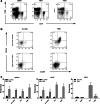Cellular and cytokine-dependent immunosuppressive mechanisms of grm1-transgenic murine melanoma
- PMID: 22674057
- PMCID: PMC3506202
- DOI: 10.1007/s00262-012-1290-9
Cellular and cytokine-dependent immunosuppressive mechanisms of grm1-transgenic murine melanoma
Abstract
Grm1-transgenic mice spontaneously develop cutaneous melanoma. This model allowed us to scrutinize the generic immune responses over the course of melanoma development. To this end, lymphocytes obtained from spleens, unrelated lymph nodes and tumor-draining lymph nodes of mice with no evidence of disease, and low or high tumor burden were analyzed ex vivo and in vitro. Thereby, we could demonstrate an increase in the number of activated CD4(+) and CD8(+) lymphocytes in the respective organs with increasing tumor burden. However, mainly CD4(+) T cells, which could constitute both T helper as well as immunosuppressive regulatory T cells, but not CD8(+) T cells, expressed activation markers upon in vitro stimulation when obtained from tumor-bearing mice. Interestingly, these cells from tumor-burdened animals were also functionally hampered in their proliferative response even when subjected to strong in vitro stimulation. Further analyses revealed that the increased frequency of regulatory T cells in tumor-bearing mice is an early event present in all lymphoid organs. Additionally, expression of the immunosuppressive cytokines TGF-β1 and IL-10 became more evident with increased tumor burden. Notably, TGF-β1 is strongly expressed in both the tumor and the tumor-draining lymph node, whereas IL-10 expression is more pronounced in the lymph node, suggesting a more complex regulation of IL-10. Thus, similar to the situation in melanoma patients, both cytokines as well as cellular immune escape mechanisms seem to contribute to the observed immunosuppressed state of tumor-bearing grm1-transgenic mice, suggesting that this model is suitable for preclinical testing of immunomodulatory therapeutics.
Figures






References
-
- Andersen MH, Pedersen LO, Capeller B, Brocker EB, Becker JC, thor Straten P. Spontaneous cytotoxic T-cell responses against survivin-derived MHC class I-restricted T-cell epitopes in situ as well as ex vivo in cancer patients. Cancer Res. 2001;61:5964–5968. - PubMed
-
- van Houdt IS, Sluijter BJ, Moesbergen LM, et al. Favorable outcome in clinically stage II melanoma patients is associated with the presence of activated tumor infiltrating T-lymphocytes and preserved MHC class I antigen expression. Int J Cancer. 2008;123:609–615. doi: 10.1002/ijc.23543. - DOI - PubMed
MeSH terms
Substances
LinkOut - more resources
Full Text Sources
Other Literature Sources
Molecular Biology Databases
Research Materials

